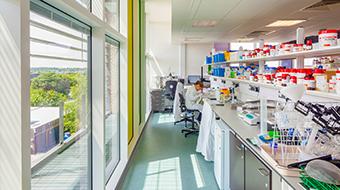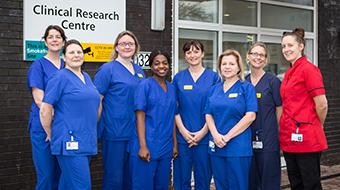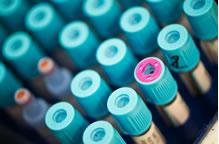Dr Amy Dodd - Anaesthetics
GMC number: 7016130
Year & location of first qualification: 2008, Oxford University
Specialty: Anaesthetics
Clinical interests: Perioperative allergy, vascular anaesthesia, obstetrics
Secretary: Anaesthetic Department
GMC number: 7016130
Year & location of first qualification: 2008, Oxford University
Specialty: Anaesthetics
Clinical interests: Perioperative allergy, vascular anaesthesia, obstetrics
Secretary: Anaesthetic Department
GMC number: 6089173
Year & location of first qualification: 2000 - Lusaka, Zambia
Specialty: Microbiology
Clinical interests: Antimicrobial Stewardship
Secretary: Josephine Poad
Secretary phone number: 0117 414 6273
MRCP, FRCPath
If you want to find out more about the research we do, or have any other related query, simply get in touch with the relevant team.
Director of Research: Professor Fergus Caskey
Deputy Director of Research: email: helen.lewis-white@nbt.nhs.uk
Research Communications team contact details:
Research.Communications@nbt.nhs.uk
Research Finance team contact details:
ResearchFinance@nbt.nhs.uk
Research Sponsorship Team contact details:
ResearchSponsor@nbt.nhs.uk
Research Facilitation Team contact details:
Research@nbt.nhs.uk
Research Infrastructure Manager: Angelo Micciche
Research Grants & Development team contact details:
researchgrants@nbt.nhs.uk

Find out more about our research and how we're working to improve patient care.
Explore the ground-breaking research currently taking place at North Bristol NHS Trust.
Research & Development
North Bristol NHS Trust
Level 3, Learning & Research building
Southmead Hospital
Westbury-on-Trym
Bristol, BS10 5NB
Telephone: 0117 4149330
Email: research@nbt.nhs.uk
In some cases, such as with the vaccine trials for COVID-19 or our ongoing maternity research, an open call will be shared with the public to try and recruit large numbers of participants. These are often for UK-wide studies, aiming to find out what treatments are likely to be helpful for the largest amount of people.
Clinical research is essential for developing better treatments and improving healthcare. Many patients take part in clinical research to help us to find the best ways to:
Even though you may be interested in taking part, we have to be sure that you fit the narrow criteria for that study and are eligible. This might take into account your current health status, history, age, gender, etc. Eligibility is often quite specific to ensure that the people who take part are not exposed to avoidable risks.
Should you be interested in getting involved in our research in the absence of an open call, you may find yourself well suited to one of our Public Involvement Groups. These are an opportunity to share your experiences, regardless of your health status, to help further the research that takes place at NBT.
To see the full range of research that is currently taking place across the hospital, please visit Our Research pages.

Want to find out more about our research? Simply get in touch with a member of our team here.
Research & Development
North Bristol NHS Trust
Level 3, Learning & Research building
Southmead Hospital
Westbury-on-Trym
Bristol, BS10 5NB
Telephone: 0117 4149330
Email: research@nbt.nhs.uk

GMC Number: 7073714
Year of first qualification: 2010, University of Oxford
Specialty: Diabetes & Endocrinology and General Internal Medicine (dual accredited)
Clinical interest: insulin pump therapy and diabetes technology, pituitary disease, antenatal diabetes and endocrinology, education
Whilst the majority of reference ranges will stay the same, some are quite different. Specific protocols and reference range information is displayed below.
Analyte
| Current NBT Adult Reference Range | NEW ADULT REFERENCE RANGE FROM 24/04/2023 |
|---|---|---|
| APTT | 21.0 – 33.0 secs | 25-37 secs |
| Clauss Fibrinogen | 1.5 – 4.0 g/L | 2-4 g/L |
| D-Dimer | < 0.50 ug/mL FEU | < 500 ug/L FEU (Age adjusted D-Dimer range) |
For Special Coagulation tests (Thrombophilia, Lupus Anticoagulant and Factor Assays), relevant comments will be added to results as appropriate.
Please note that Paediatric ranges have not changed.
Haemoglobinopathy change in platform:
As of as of 18/12/2023, the first line haemoglobinopathy testing analytical method has changed. It is approved for use in sickle cell and thalassaemia (SCT) screening programme and has been verified in-house at NBT
The new reference range will therefore start at 90% (change from 80%). The previous method separated some HbA fractions, which no longer applies to the new method, but this has no impact on the interpretation of results.
HbA2 values are comparable across platforms and reference ranges and interpretation have not changed.
HbF less than 0.3% is not detectable on the new analyser and results less than this will therefore be reported as HbF <0.3%.
There will be no changes to the way that haemoglobin variants and thalassaemias (carriers and disease) are reported.
We are updating both our test information pages Test Information and the quality section Pathology Accreditation and Compliance Status with details of assays affected.
All the tests, which were previously accredited by UKAS, will be going under an Extension to Scope process. However, please be assured that the quality of our services will remain the same.
If you have any concerns or queries, please contact us (https://www.nbt.nhs.uk/severn-pathology/pathology-services/haematology/contact-haematology).

Includes details of sample types, volumes, special precautions, turnaround times & reference ranges.

The SNAHPer group are delighted to share with you a series of recorded webinars, to help you think, plan and develop your research-related activities.
Webinar 1 - Demystifying Research
Webinar 2 - Using Evidence to change practice
Webinar 3 - Do I matter to research
Webinar 4 - Designing your roadmap to success
Webinar 6 - There's no 'I' in Team
Explore the ground-breaking research currently taking place at North Bristol NHS Trust.

Find out more about our research and how we're working to improve patient care.
Research & Development
North Bristol NHS Trust
Level 3, Learning & Research building
Southmead Hospital
Westbury-on-Trym
Bristol, BS10 5NB
Telephone: 0117 4149330
Email: research@nbt.nhs.uk
This information aims to increase your understanding of how to be an active part of your own recovery after surgery. If there is anything that you are unsure about, please ask. It is important that you understand the programme, so that you, your family and friends can be involved.
This is the programme offered by North Bristol NHS Trust for patients undergoing planned gynaecology surgery. There may be circumstances where the programme will not be appropriate for some patients and if this is the case, you will be fully informed of the alternatives.
The Enhanced Recovery Programme is to get you back to full health as quickly as possible after your operation. The hyperlink below will take you to a short video about Enhanced Recovery called "Fitter Better Sooner". We strongly encourage you to watch the video:
Fitter, Better, Sooner Toolkit | Centre for Perioperative Care (cpoc.org.uk)
Research indicates that after surgery, the earlier you get you out of bed, exercise, eat and drink, your recovery will be quicker and with less risk of complications. Some of the benefits include:
To achieve this, we need you to be partners with us working together to speed up your recovery.
The medical staff will see you in the outpatient’s department to explain your operation. Following this you will be sent a date to attend the pre-operative assessment clinic, where trained staff will carry out routine tests that are required to ensure you are fit and safely prepared for surgery.
When you attend the preoperative assessment clinic, we will explain the programme to you and your family. You will be provided with written information, time to ask questions and may be referred to the anaesthetist. The nurse will discuss your arrangements at home so that together we can plan for any help you may need after your operation. All patients are screened for potential infections at this appointment.
We will discuss diet and exercise with you and if necessary, you will be referred to the dietician. For example, if you have lost a lot of weight or your appetite is poor.
It is important to keep as active as you can before your operation and if you are a smoker you should stop now. This helps reduce breathing problems after surgery. You can see your GP or pharmacist for advice on products to help you stop smoking.
Please bring:
Prior to your surgery you will be able to eat and drink as normal unless you are required to take medication to clear the contents of your bowel. If this applies to you it will be discussed with you at pre operative assessment. It is important to have a variety of non-fizzy drinks during your hospital stay.
You may continue to eat for up to six hours before your operation and drink clear fluids for up to two hours before.
To help prevent blood clots you will be required to wear special support stockings (TEDS). The nurse will measure your legs to choose? the correct size. You will also be given an injection called ‘clexane’ in the evening. This helps reduce the risk of blood clots by thinning the blood. The injection will be given each day you are in hospital.
Some patients at higher risk of experiencing blood clots may need to continue the injection at home. This would only be temporary and will be discussed with you when you are in hospital. Most patients can inject themselves or with the help of a relative or carer. The nurses on the ward will show you how to do the injection. If you have problems with giving yourself the injection we will arrange for a District Nurse to visit you.
For those also having an operation on their bowel: You may need an enema to empty your bowel contents on the day of your operation. After an enema, it is important to drink plenty to replace any fluid lost. Some patients may have to take medication the day before to achieve this (if this applies to you more information? will be given).
It is very important to keep yourself warm before your operation and you are advised to dress accordingly (warm dressing gown, socks, slippers, blankets etc.) When it is time for your operation you will be required to wear a hospital gown.
You may hear the staff on the ward talk about “dreaming”. They are not talking about what happens when you are asleep! In fact, they are talking about some of the most important components to successful recovery after surgery- Drinking, Eating and Mobilising also known as DrEaMing. We know that if you can “DrEaM” within 24 hours of your surgery, you will be on track to recover quicker, sooner and better.
To help you with this we will create a rhythm to your day that follows the pattern of eating a meal in a chair, mobilising, then resting.
It is important to start drinking and eating as soon as you can after surgery. Initially some patients may find a low fibre diet more tolerable. We encourage you to sit out of bed for your meals to help build your strength and mobility.
Studies show that chewing gum after surgery can improve your recovery by assisting the bowel to return to normal. Chewing gum can also help disperse trapped wind that can sometimes occur after surgery. We advise that on the day you come into hospital, you bring chewing gum with you. After your operation chew gum for 15 minutes, a few times a day, until your bowel function returns to normal.
Staff will help you out of bed about six hours after your operation. We encourage you to eat all your meals sitting in a chair. After your meals we suggest that you move around the ward as you are able. The staff on the ward will assist with this if required. After this gentle exercise, it is important to return to bed for some rest.
Following your operation, it is important that you do deep breathing exercises to prevent chest infection. You will need to do deep breathing exercises every hour. To do these you will need to:
You should cough regularly to make clear your lungs of secretions. To do this, place a towel or pillow over your incision site, support it with your hands and cough.
When you are sitting in the chair or lying in bed, you should do frequent leg exercises as prevention against blood clots. To do this point your feet up and down and move your ankles as if making circles.
By being out of bed in a more upright position and by walking regularly, lung function is improved and there is less chance of a chest infection after surgery. Circulation is also improved, reducing the risk of blood clots and helping bowel function return to normal.
Try and wear your day clothes after your operation as this can help you feel positive about your recovery.
Below is a video of some examples of breathing and leg exercises:
It is important that your pain is controlled so that you can walk about, breathe deeply, eat and drink, feel relaxed and sleep well.
Various tablets can be used for pain for example paracetamol, ibuprofen, codeine and morphine (liquid or injections, as needed). Pain control is really important, and there are additional ways of giving painkillers if the above medicines are not sufficient. You will need to take your painkillers regularly (three or four times per day) to make sure you are comfortable.
If you are uncomfortable or in pain, then please tell the nursing staff immediately and they will be able to help you.
After an operation and anaesthetic it is not uncommon to feel nauseated and vomit. You will be given medication during surgery to reduce this. If you feel sick following surgery please tell a member of staff who will be able to give you something for this.
We will want to make sure that you are able to pass urine after your surgery. If we are concerned that this may be
difficult due to your operation, a tube (catheter) may be placed into your bladder so that we can check that your kidneys are working well and your urine output can be measured. If you have a catheter, it will be removed as soon as possible.
You will have an intravenous drip put into your arm to ensure you do not become dehydrated. The drip will normally be removed the day after surgery, but you may still have the intravenous port (venflon) in case we have to give other drugs through it. You may also be required to breathe extra oxygen for a short while after your operation.
It is normal to have vaginal bleeding after gynaecological operations. This bleeding may be like a light period. Tampons must not be used for bleeding after surgery.
Many different things will be monitored during your treatment including:
Please remember to tell us about everything that you eat and drink and what you pass.
Whilst you are in hospital you will be asked to participate in maintaining a ‘daily diary’ (provided by the ward), so that you
can keep a record of how well you are managing, in particular with diet and exercise after surgery. This will also help us monitor your progress.
Decisions regarding patient care are at the discretion of your consultant. Patients who are no longer able to follow the structure of the programme will revert to a traditional plan of care.
Complications should not happen very often, but it is important that you know what to look out for. During the first two weeks after surgery, if you are worried about any of the following (see information on the following page), please phone the telephone numbers on this leaflet. You should be able to reach a member of staff at any time. If you cannot contact the people listed, then ring your GP or NHS 111.
If you have had surgery on your bowel, the hospital team will phone you at home initially to check on your progress. In between these times if you have any concerns, you can contact them on the numbers provided.
It is not unusual to suffer pains during the first week following surgery. Continue taking your painkillers regularly.
If you have severe pain lasting more than 1-2 hours or have a fever and feel generally unwell, you should contact
us on the telephone numbers provided
The Ward nurses will remove your wound dressing before discharging you home. If you have had keyhole surgery you will have dissolvable stitches and glue over the top. You may continue to take showers or baths.
For surgery where a larger incision has been needed, either dissolvable stitches are used, or a stitch that needs to be removed. This can be taken out with the GP practice or district nurse about 5-7 days after surgery, and we will discharge you with a plan for this. It is not unusual for your wounds to be slightly red and tender during the first 1-2 weeks. You may also notice bruising.
Please let us know if your wound:
It is not uncommon to have some vaginal discharge or bleeding after surgery. Light bleeding like the end of a period is normal for a few weeks after surgery. This can be red, pink or brown in colour. If your bleeding is heavy, like a period, or with blood clots, you should contact the ward directly. If you have an unpleasant smell to the discharge this could indicate an infection. Please contact your GP or call Cotswold Ward for advice. Bleeding/discharge can continue for 10 days to 2 weeks following surgery, and should then settle. No tampons should be used during this time and intercourse should be avoided for 6-8 weeks.
In the early stages following surgery, your bowel habits may change and may either become loose or constipated. Make sure you eat regular meals 3 or more times a day, drink adequate amounts, and take regular walks the first two weeks after your operation.
Please seek advice from your GP if you are experiencing prolonged constipation.
Sometimes after surgery you may experience the feeling of a full bladder. This usually resolves, however if you experience any of the following problems please contact your GP, or ring Cotswold Ward for advice:
A balanced, varied diet is recommended and particularly eating 3 or more times a day. If you are finding it difficult to eat it is still important to obtain an adequate amount of protein and calories to help your body heal. You may benefit from having 3-4 high protein, high calorie drinks such as Build-up or Complan (available in supermarkets and chemists) to supplement your food. It is important to drink plenty of water.
We encourage activity from day one following surgery. You should plan to undertake regular exercise several times a day and gradually increase during the 4 weeks following your operation until you are back to your normal level of activity. The main restriction we place on exercise is that you do not undertake heavy lifting 4-6 weeks following your surgery. If you are planning to restart a routine exercise such as jogging or swimming we suggest that you wait until 2 weeks after surgery and start gradually. Common sense will guide your exercise and rehabilitation; in general if the wound is still uncomfortable modify your exercise. Once the wounds are pain free you can undertake most activities.
When you return to work will depend on the type of operation you have had, your surgeon will guide you on this. Many
people are able to return to work within 2 - 4 weeks following their surgery. If your job involves lots of lifting we suggest you ask your employer to give you lighter duties until you are fully recovered.
It is advised that you do not drive until you are confident that you can drive safely. Usually this is when you are doing most of your normal activities. In general this will be 4 weeks after surgery. It is important that any pain has resolved sufficiently to enable you to perform an emergency stop. You should contact your insurance company to check their terms or you may not be fully insured.
For certain types of operations, it is advisable to avoid intercourse for 6-8 weeks following surgery, please check
with your surgeon. We advise that you wait until any vaginal bleeding has stopped.
Naturally if you are not wishing to get pregnant contraception is important to consider, as you will continue to ovulate after your surgery, and you can fall pregnant quickly.
In general it is advised that you take up your hobbies and activities as soon as possible again after surgery. It enables you to maintain your activity and will benefit your convalescence. We would not advise restricting these unless they cause significant pain or involve heavy lifting within the first 6 weeks following surgery.
You may continue with your normal medicines unless directed to stop by your doctor. You will be given a new supply of these if you do not have enough at home. You will also be given pain killers and any other medicines required, to take home.
Not all patients require an appointment after their surgery if your Consultant thinks a follow-up appointment is needed, this will be sent through the post.
Follow up appointments allow the team to see how you are and talk through any further treatment.
If you have had an operation on your bowel, you will be contacted at home via telephone after your operation by the nursing team. We also encourage you to contact the specialist nurse or ward if you are experiencing problems.
Fitter Better Sooner:
Preparing for surgery – Fitter Better Sooner | The Royal College of Anaesthetists (rcoa.ac.uk)
Endometriosis UK Charity:
Your laparoscopy | Endometriosis UK (endometriosis-uk.org)
Page last reviewed December 2023
Page due for review December 2026

North Bristol NHS Trust (NBT) is part of the Bristol NHS Group, a partnership with University Hospitals Bristol and Weston NHS Foundation Trust (UHBW).
As two major NHS providers, we have come together as an NHS Group to deliver seamless, high-quality, equitable and sustainable care for every person across Bristol, Weston, South Gloucestershire, and the wider South West.
With 28,000 staff and a combined turnover of over £2.2 billion, this partnership gives us the scale, influence and expertise to transform the way healthcare is delivered locally.
Chaired by Ingrid Barker and led by Maria Kane as Group Chief Executive, Bristol NHS Group unites the two Trusts to transform the way healthcare is delivered locally with a clear focus on making a difference for what we call our ‘Four P’s’:
Bristol NHS Group has set out its priorities in a Summary Benefits Case, to improve healthcare for the communities it serves:
You can read more about what Bristol NHS Group will deliver in our Summary Benefits Case.
As part of our plans to deliver seamless, high-quality, equitable and sustainable care for everyone who needs it, Bristol NHS Group is exploring how NBT and UHBW might become a single, merged organisation in the future.
Exploring the benefits and opportunities of operating as a single organisation, a merger could help to remove some of the legal barriers and complexities that get in the way of delivering our Joint Clinical Strategy, which aims to provide even better care by reducing duplication, investing in frontline services, and strengthening integration across our hospitals and communities.
This is not a final decision, but the beginning of a thorough process to shape and inform one – with staff, patient and stakeholder engagement at its heart. There are no changes to services at this point apart from our ongoing Single Managed Service programme (see below for more information). Our focus remains on maintaining stability, improving care for patients, in alignment with the government's plan for health. In particular, the three shifts from: sickness to prevention; hospital to community; analogue to digital.
Our Joint Clinical Strategy (JCS) sets out our vision to deliver seamless, high-quality, equitable and sustainable care for everyone who needs it. Developed by clinicians from across both Trusts, it sets out how we will combine our collective strengths to make a bigger difference for our patients, our people, the population we serve, and the public purse (the Four Ps).
Patients should never experience delays, duplication, or confusion because of where they live or which hospital they attend. Through this strategy, we will break down those barriers - ensuring care is consistent, connected and of the highest possible standard, wherever it’s delivered.
To make this happen, we are introducing Single Managed Services (SMS) — a new way of delivering clinical services across our two Trusts. Our vision is for more joined-up, more resilient, and more patient-focused services.
Cardiac Services is the first specialty to develop an SMS to help meet rising demand and deliver more high-quality, consistent care for its patients.
Cardiology care continues to be provided by both Trusts across Southmead Hospital, Weston General Hospital and the Bristol Heart Institute (BHI), but is now managed by one leadership team.
Working together as one service across the Group will help Cardiac Services use its resources together to reduce waiting times and ensure equitable access to treatment. It will also enhance patient experience by aligning patient pathways and improving communication for more seamless care.
To make sure that our patients and communities have a real voice in the future of their healthcare services locally, we are establishing a Community Participation Group (CPG). This group will provide independent oversight, advice and input on how to involve patients and public in the development of our services.
The CPG will be representative of our communities, Patient and Carer Partners and Governors, providing opportunities for new voices to be heard.